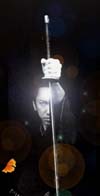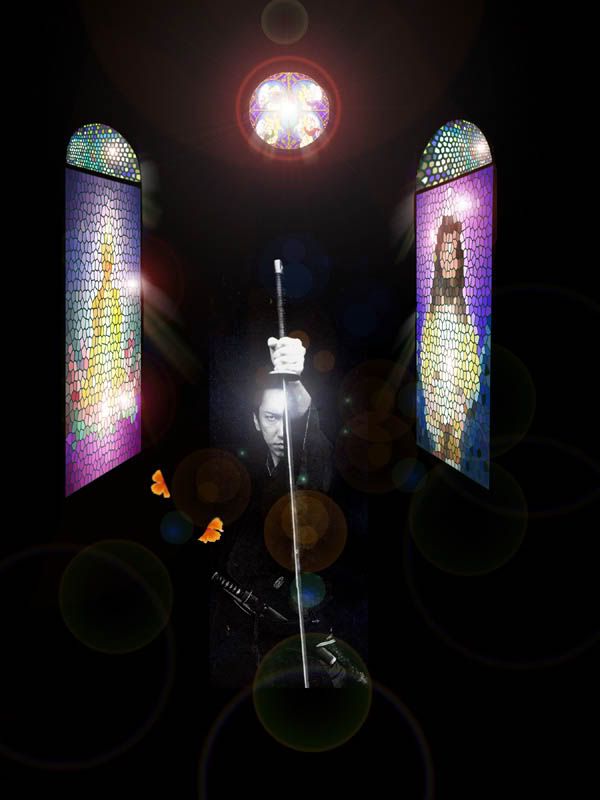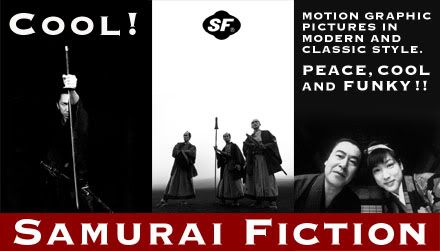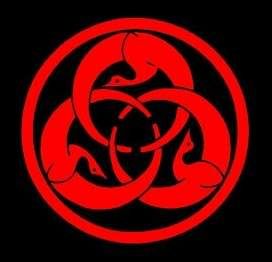|
My Bushido
Zen 2005.05.23. 01:31
 Sometimes I make digital pictures, like this one,- Sometimes I make digital pictures, like this one,-
represents a warrior walking on his path,
between two religious ways,- the Buddhist,
and the Christ...

Hotei Tomoyasu,- actor, singer, picture taken from the movie
Samurai Fiction.

The other two icons up there, on the windows in the church are
these,- also mine painted with pastell colors,- finally turned it into
mosaic in Photoshop:


;-]
History of the Samurai
The following is a brief history of the
samurai.
source:
unknown, internet
By
200 AD, rice cultivation had been known on the islands east of the Asian
continent for 500 years. With agriculture had come ownership of land where
previously, boundaries between small nomadic hunting groups had been indistinct.
People came to live together in communities, sharing in the work of planting and
harvesting, and in defense against others who would take their winter stores.
With the possession of land had come war.
The growth of
farming drew people away from hunting and away from hunting skills. Some were
naturally better suited to fighting then others and so honed those skills,
becoming specialists at fighting. Those who fought became warriors, and by
virtue of their strength, became the leaders of their clans. The wars they
fought resulted in larger clans overcoming and absorbing smaller ones. Japanese
society of the third century was composed of many clans, capable and willing to
wage war for advantage. It would not be very long before they became one
society.
By 200 AD, the
Chinese Han court had received envoys from as many as 30 clans from northern
Kyushu through their offices on the Korean peninsula. The ancestors of the
Japanese had much more reason to look west than to the northern wilderness since
the west held much to attract them in both materials and technology. Korean iron
and weapons were particularly desirable. Shortly after the fall of the Han in
220 AD, Kyushu clans, capable and willing to wage war for advantage,
attacked.
Warriors of this
era fought on foot with bows, stabbing swords, and spears. Armor was worn, but
most warriors probably had only shields. Steel and bronze had come to the
Japanese islands with rice and so they knew of and used these materials. The
more advanced technology and the better materials, however, were still from the
continent.
By 300 AD the
religious, political, and military consolidation of independent clans culminated
with the Yamato clan becoming dominant. Included in the consolidation were clans
on northern Kyushu and southern Honshu. The Yamato were in power because of the
support of many clans rather than the surrender of those clans. The Yamato
culturally consolidated early Japanese society; administratively, many local
clans remained relatively independent. Archeological excavations show that mound
tombs constructed in this time were all very similar and yet widely distributed.
They demonstrate the cultural unity of the people, the independence of
distributed clans, and the measure of their power over the lower classes. Yamato
invasions of the Korean peninsula were frequent, leading even to the
establishment a land hold. The tip of the peninsula, called Mimana, long under
the influence of the islanders, was established as their own domain and base for
raids in the fourth century. From this presence, the flow of culture and
technology was assured.
War with the
continentals was not always a matched fight, however. Shortly after 400 AD, the
enemy demonstrated that they had learned to fight from horseback. Up until that
time, horses, though available, had not been ridden in war by the Yamato.
Shooting an arrow from horseback required two hands. Until the invention of
stirrups in China in the first century, falling off one's horse was a much more
likely event than successfully launching a home hitting arrow. With stirrups
providing two sided support and a saddle to brace one's knees, a warrior could
stand, use his feet to guide the horse, shoot arrows, and swing a sword. With
the additional speed offered by a mount, foot soldiers could be easily surprised
and devastated by many fewer men. The Yamato participated in politics and
culture on the Korean peninsula directly. Alliances were made and war waged.
Even marriages were arranged between courts. The Yamato and Paikche found a
common enemy in the Silla and so allied against them. Paikche and Yamato, as
allies, exchanged knowledge and material. Scribes arrived in Yamato almost
immediately after contact. Buddhism arrived in 538. Sword smiths, armorers, and
horses all made their way to Yamato. By 600, one third of the Yamato court was
composed of foreign immigrants brought to Yamato for their advanced knowledge
and skills. In time, the developed skills of the Yamato made their products so
desirable that the exchange reversed, and weapons and horses were exported back
to the Paekche to aid in the fighting.
Foreign wars
were not all that concerned the Yamato, however. Unity in the Yamato court was
not the rule. Prior to the 6th century, the Great Lord was the religious and
political leader of the nation. (The Yamato ruler had not yet been attributed
with divine authority.) The position was hereditary, but without rules for
ascension. Each Great Lord kept consorts in great numbers and so it was not
always apparent who would reign next. Since power was involved, outside clans
often tried to gain influence by marrying daughters to princes in the hope that
a son-in-law prince would become Great Lord. To that end, clans would support
their son-in-laws by murdering rivals or by waging war on other clans. One clan
warrior was so thorough in killing off competitors, that when his chosen prince
died shortly after taking office, a wide search found that the only hereditary
choice remaining was a prince who had been in hiding and who was patronized by a
rival clan.
War on the
Korean peninsula eventually led to the expulsion of the Yamato from Mimana in
562. During the continental wars before and after their expulsion, the Yamato,
having become skilled as mounted archers, were often called upon to help their
allies. The warriors sent to the continent rode horses which were small, perhaps
40" at the shoulders. Armor for the horses was excluded so that they would be
quick. Arrows were the weapon of choice. Swords were used from horseback, but
most likely only after arrows had been depleted. Armor was therefor designed
primarily to repel arrows.
In 663, with
support from the Tang dynasty in China, Silla overwhelmed Yamato and Paekche
forces in a deafening defeat. The Chinese had brought new tactics to the
battlefield for directing mass peasant armies armed with crossbows. With this
defeat, Silla went on to unify the peninsula. Yamato, now reeling with the
likelihood of invasion from abroad, withdrew to defend itself.
Just as the
Yamato began organizing for defense, difficulties at court took precedence over
defense. The Great Lord died and in a subsequent civil war, the next leader,
Temmu, took power by the military defeat of his brother.
Temmu became the
first "Heavenly Warrior Emperor" of Japan. From the experience of losing to the
Chinese and from fears of invasion, Temmu established laws to control the
military strength of the nation. Having taken the throne by force, he knew
especially well that military power meant ruling power. A peasant conscript army
was established, with weapons being the possessions of the government.
Conscripted service for border guards was required of all clan warriors for
periods of three years. Horsemen were to train continuously, peasants 10 out of
100 days. Skills to be practiced included swinging swords, stabbing with spears,
firing crossbows, and catapulting stones. "In a government, military matters are
the essential thing." stated Temmu.
 Temmu also knew
the value of diplomacy. Several missions were sent to China, carefully avoiding
the Korean peninsula. It was during their first direct contacts with the Tang
dynasty that the Yamato first began referring to their islands as the "sun
source" or "Nippon". The Chinese pronounced the same characters as "Jihpen". It
is this sound which Marco Polo brought back to Europe in the thirteenth
century.
The Kanto plain
in central Honshu was ideal for raising horses, and perhaps from hunting and
military engagements with northern barbarians or "Emishi", the Kanto warriors
had long been known as the fiercest of Japan. Eventually, because of their
greater skill, border guards came to be Kanto plain warriors almost exclusively.
Some of the first written documents available from Japanese history are poems
written by warriors about service as border guards:
"From
today
Without regard for
myself
I set out
A shield strong but
humble
For our Sovereign
Lord."
In time,
however, the threat from the continent diminished and raids from the Emishi
became a more pressing concern. In the eighth century, conscripts and Kanto
mounted warriors were sent to the north to bring the tribes under court control.
The Emishi were
fast horsemen, however, and fought a guerrilla style war. Conscript armies were
not effective and were often overwhelmed. The wars eventually stretched the
financial limits of the government, and with a population decline due to
smallpox and crop failures, armies came to consist only of mounted archers.
Crossbows for the peasant armies proved too expensive. Also due to expense and
to the rusting failure of iron armor, the government turned to leather armor.
The benefit of light weight was an added attraction.
 By the end of
the eighth century, the Japanese warrior fighting in the northern extents of
Honshu essentially fit the historical model of the classical Japanese warrior.
By this time, the government had come to depend on the men of the Kanto to such
an extent that courtiers no longer personally took up arms. The term "samurai",
meaning "those who serve" came into use (although with derogatory meaning when
used by pretentious courtiers). Warriors continued to fight on horseback, with
bow and arrows as their primary weapon, but also with a newly designed sword.
The Emishi had been found to be fighting with curved swords. These seemed much
better suited to slicing cuts inflicted from horseback, and so the Japanese
tachi, which had previously been modeled on the continental sword, was revised
for the same effect.
Samurai Time Line
660 B.C.
Legend says Jimmu Tenno became Japan's first emperor and set up the ruling
Yamato State. Weapons and armor develop.
400's A.D.
Horses introduced to Japanese fighting.
500's A.D.
Buddhism arrives in Japan; becomes a powerful philosophy for rulers and
warriors.
646 A.D.
Taika Reforms Began.
702 A.D.
Taiho law codes established the Great Council of
State.
710 A.D.
The Japanese court establishes first long term capital
in the city of Nara.
794 A.D.
Heian period begins, the capital is moved to the city of
Kyoto.
858 A.D.
Taira Masakado revolted and proclaimed himself "The New
Emperor." Other samurai leaders exerted their influence across the land
and changed the history of Japan.
900's A.D.
The warrior class gains strength in the
countryside.
995 A.D.
Fujiwara Michinaga comes to
power.
1000
A.D. Sei Shonagon composes "The Pillow
Book"
1008-20 A.D. Murasaki Shikibu writes "The Tale of
Genji"
1160 A.D.
Taira Kyomori over comes the Minamoto to become military
leader of Japan, Fujiwara dominance ends.
1180-85 A.D.
Minamoto Yoritomo takes up arms against the Taira clan in The Gempei War.
And establishes the Kamakura bakufu Heian era ends.
1192 A.D.
Yorimoto became first permanent Shogun of japan and set up his
samurai government in Kamakura.
1274 A.D.
Mongols invade Japan. The samurai defeat the Mongols after many
years of fierce fighting, that change the way wars are fought by the samurai.
A second attempt by the Mongols in 1281 also fail. They develop a
style of formation combat and depend more on swords as a primary weapon in
battle.
1331-33 A.D.
Go-Daigo becomes the 96th Emperor of Japan. After
battling Emperor Go-Daigo for supremacy, the Kamakura bakufu is
overthrown.
1336 A.D.
Ashikaga Takauji defeats Go-Daigo's forces and names a new
emperor in Kyoto, Go-Daigo sets up a southern court.
1392 A.D.
The northern and southern courts are
reconciled.
1400's A.D.
Master swordsmen establish dojos to teach kenjutsu.
1467-77 A.D.
The Onin War sees the decline of Shogun power and begins the Sengoku Jidai
(The Age of the Country at War) which last 150 years.
1543 A.D.
Portuguese guns are introduced into
Japan.
1549 A.D.
Jesuit Francis Xavier arrives and begins
proselytizing.
1560 A.D.
Oda Nobunaga begins the process of unifying Japan.
1568 A.D.
Oda Nobunaga seizes Kyoto, Sengoku Jidai draws to
a close.
1573 A.D.
Last Ashikaga shogun is expelled from
Kyoto.
1575 A.D.
Nobunaga and Tokugawa Ieyasu win battle at
Nagashino.
1582 A.D.
After Nobunaga is assassinated, Toyotomi
Hideyoshi seizes power.
1592 A.D.
Hideyoshi invades Korea for the first time, a
second invasion occurs in 1597.
1598 A.D.
Troops are withdrawn from Korea after Hideyoshi
dies.
1600 A.D.
Ieyasu asserts military hegemony with a victory at
Sekigahara, the first Dutch ship arrives.
1603 A.D.
Tokugawa Ieyasu acquires title of shogun, Okuni's
troupe perform first kabuki dances in Kyoto.
1605 A.D.
Miyamoto Musashi, Japans most famous swordsman,
begins hi musha-shugyo (Warrior Pilgrimage). Musashi fought and won more
than 60 duels before the age of 30. He founded the Individual School of
Two Skies and taught for many years. At the age of 60, Musashi wrote Gorin
No Sho (The book of Five Rings), the most famous writing about the Japanese
sword arts. He also wrote "The 35 Articles on the Art of
Swordsmanship."
1610 A.D.
The Dutch establish a trading post on
Kyushu.
1612-14 A.D.
Tokugawa expels the Franciscans and Jesuits and outlaws
Christianity.
1615 A.D.
Osaka Castle falls to Tokugawa, Tokugawa
Ieyasu draws up the Buke Sho Hatto (Rules for Martial Families) before his
death. It gave the samurai 13 guides to living as a warrior during peace
time.
1630 A.D.
Japan closes its doors to the outside world
for more than 200 years.
1648 A.D.
Genroku era begins.
1694 A.D.
Matsuo Basho's "The Narrow Road to the
Deep North" is published.
1703-08 A.D.
Earthquakes, floods, and fires ravage Japan, Mount Fuji erupts, and
a measles epidemic breaks out.
1704 A.D.
Genroku era ends.
1854 A.D.
Commodore Matthew Perry opened trade between
the United States and Japan.
1867 A.D.
Emperor Mutuhito regained his traditional
powers and took the name Meiji. It was the beginning of the Meiji
Restoration. Meiji set up his new capital city in Edo (Tokyo).
1868 A.D.
Emperor Meiji introduced the "Five Articles
Oath" which began the dismantling of the Samurai caste.
1873 A.D.
Emperor Meiji established an army based on
conscription; an army open to anyone.
1876 A.D.
Emperor Meiji declared a new law that ended
the wearing of swords. The samurai had lost their profession and their
right to wear swords. Their position as a special class ended after almost
1,000 years.
Famous Samurai
Here are a few famous samurai, click on the names to read
more about them. The links go to the Samurai Archives an awesome web site
on samurai history. There are more famous samurai on that site than I have
listed here.
Akamatsu Mitsusuke:
Ashikaga period Shugo and the assassin of Shogun Ashikaga Yoshinori (D.
1441)
Baba Nobufusa: Mino
no Kami; one of 'Shingen's Twenty-four Generals' (1514 -
1575)
Hattori Hanzo:
Tokugawa retainer and reputed 'ninja' leader (1541 -
1596)
Minamoto Yoshiie:
Legendary warrior and hero of the 'later three-year war'
(1041-1108)
Oda Nobunaga: Daimyo
of Owari and the first of the "Three Unifiers" (1534 - 1582)

| 
